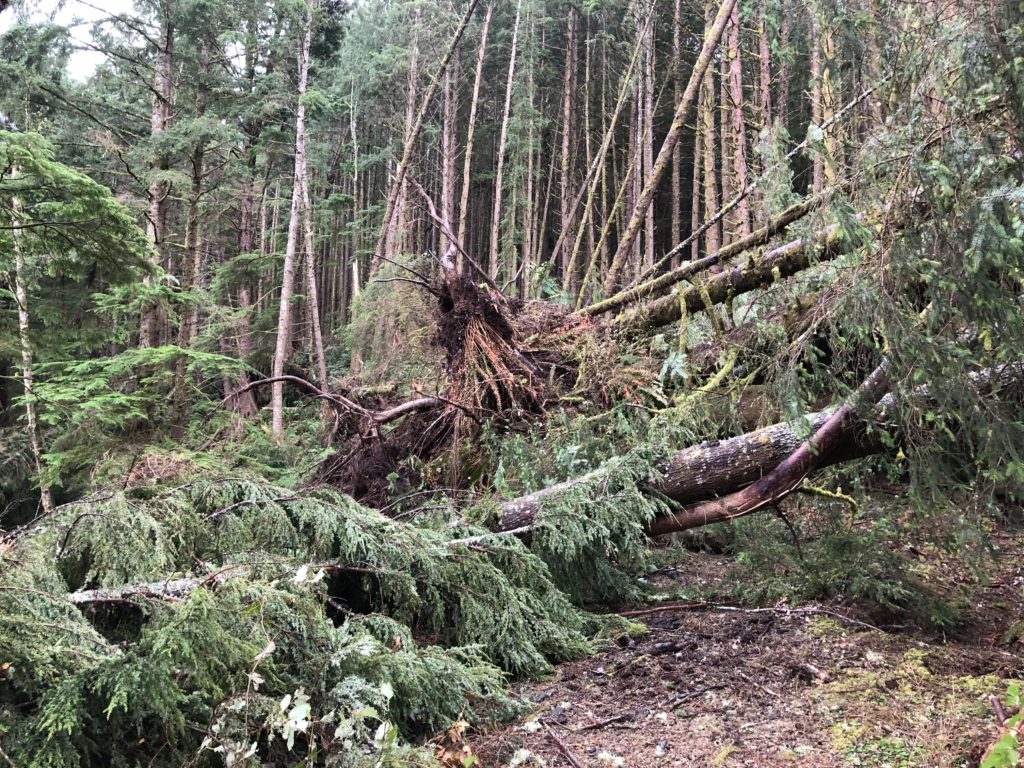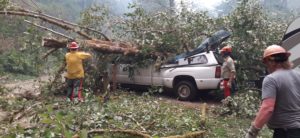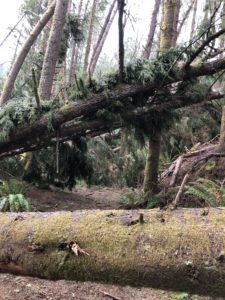
By DANA TIMS/YachatsNews.com
Kraig Lindelin spent all summer leading a three-person crew rebuilding and refurbishing the dozens of miles of trails that snake through the Cape Perpetua natural area south of Yachats.
Still, he was utterly unprepared for what he saw there in the aftermath of unusually powerful east winds that ripped across the cape’s forested hillsides Sept. 7-8.
The storm that ignited forest fires across Oregon and near Otis in Lincoln County also knocked down thousands of trees in the Coast Range, closing campgrounds, roads, recreation areas and trails throughout the Siuslaw National Forest.
“We were just starting to see light at the end of the tunnel after working there all summer,” said Lindelin, the Siuslaw trails coordinator for the central coast region. “This was 10 times worse than anything we saw at the start of the year. It was just a gut punch.”
Lindelin, recently reinforced by a handful of sawyers redeployed from other areas on the sprawling forest, is back working every day to get the cape’s trails reopened.
At this point, he said, only the popular 1.4-mile Discovery Loop Trail near Yachats remains closed.
“We’re making progress,” he said. “But there is still an awful lot of work to do. This is unprecedented for our area.”

Trails reopened since the storm’s 65 mph winds reshaping of the landscape include Giant Spruce Trail, Gwenn Creek Loop Trail, Cook’s Ridge Trail and all but the top portion of the Amanda Trail.
The Cape Perpetua Visitors Center, closed since March by coronavirus restrictions, will remain closed for the foreseeable future.
With no access by trucks to haul out any of the downed material, Lindelin and his crew are sawing wood into pieces small enough to shove off to the side of a trail.
But they remain mindful of the perils involved.
“Some of these trees are very scary to cut,” he said. “They are under a lot of tension from trees lying on top of them. It’s a very challenging log-out situation.”
Making things more difficult is the loss of considerable number of signs that had been in place directing hikers to various trailheads.
Some people have started out hiking up the ridge from the backside, only to be shocked to see what they have to crawl through to get back down, Lindelin said.
In all, some thousands of trees likely fell, he said.
“Some places were hit super hard, others not so much,” Lindelin said. “It all depended on the orientation of any particular canyon to east winds.”

Coastal winds strong enough to topple trees normally come from the southwest, said Paul Engelmeyer, manager of the Portland Audubon’s Tenmile Creek Sanctuary. What made this storm unusual was the easterly winds that downed power lines and helped spark wildfires across the coast and inland into the Cascades.
“Trees with these huge root balls are used to facing winds from the southwest every two years or so,” he said. “What they aren’t used to is easterly winds this strong. The result was just a really catastrophic event.”
Trails advocate Joanne Kittel has lived on bluff just north of Cape Perpetua for 27 years and is used to coastal storms.
“But I’ve never seen anything like this,” she said. “The entire landscape has changed.”
If there’s an upside to the blow down, it’s that it has opened large new views of the ocean from a number of Cape Perpetua’s trails, Lindelin said.
“It’s still pretty tough to adjust to it,” he said.


